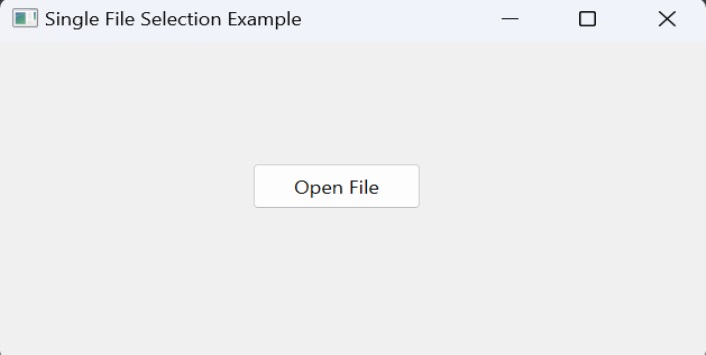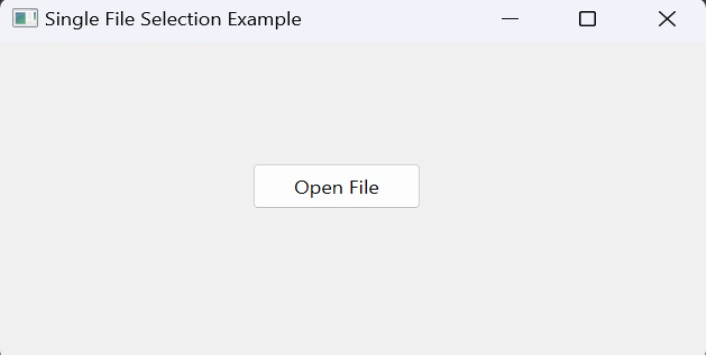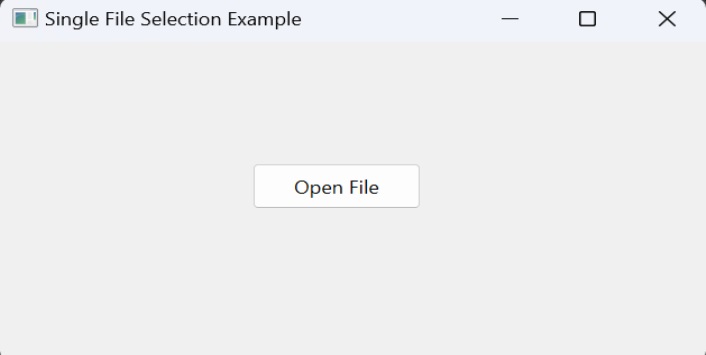
- PyQt - Home
- PyQt - Introduction
- PyQt - Environment
- PyQt - Hello World
- PyQt - Major Classes
- PyQt - Using Qt Designer
- PyQt - Meta Objects
- PyQt Signals & Slots
- PyQt - Signals and Slots
- PyQt - Support and Signals
- PyQt - Unbound and Bound Signals
- PyQt - New Signals with PyQtSignal
- PyQt - Connecting, Disconnecting, & Emitting Signals
- PyQt - Slot decorator
- PyQt - Slot Connection
- PyQt Layouts
- PyQt - Layout Management
- PyQt - QBoxLayout
- PyQt - QGridLayout
- PyQt - QFormLayout
- PyQt - QHBoxLayout
- PyQt - QVBoxLayout
- PyQt - QStackedLayout
- PyQt - QGraphicsGridLayout
- PyQt - QGraphicsAnchorLayout
- PyQt - QGraphicsLayout
- PyQt - QGraphicsLinearLayout
- PyQt Basic Widgets
- PyQt - Basic Widgets
- PyQt - Qlabel Widget
- PyQt - QLineEdit Widget
- PyQt - QPushButton Widget
- PyQt - QRadioButton Widget
- PyQt - QCheckBox Widget
- PyQt - QComboBox Widget
- PyQt - QSpinBox Widget
- PyQt - QMessageBox
- PyQt - QDialogButtonBox Widget
- PyQt - QFontComboBox Widget
- PyQt - QDoubleSpinBox Widget
- PyQt - QToolBox Widget
- PyQt - QMenuBar, QMenu & Qaction Widgets
- PyQt - QToolTip
- PyQt - QInputDialog Widget
- PyQt - QFontDialog Widget
- PyQt - QDialog Widget
- PyQt - QFileDialog Widget
- PyQt - QTab Widget
- PyQt - QSplitter Widget
- PyQt - QDock Widget
- PyQt - QStatusBar Widget
- PyQt - QTabBar
- PyQt - QList Widget
- PyQt - QScrollBar Widget
- PyQt - QProgressBar
- PyQt - QCalendar Widget
- PyQt - QMessageBox Widget
- PyQt - QPlainTextEdit
- PyQt - QDateEdit
- PyQt - QDateTimeEdit
- PyQt - QTimeEdit
- PyQt - QTextEdit
- PyQt - QTextBrowser
- PyQt - QScrollArea
- PyQt - Drag and Drop
- PyQt - Multiple Document Interface
- PyQt - QDialog Class
- PyQt Views
- PyQt - QColumnView
- PyQt - QTableView
- PyQt Drawing API
- PyQt - Drawing API
- PyQt - Drawing a Line
- PyQt - Drawing a Rectangle
- PyQt - Drawing a Triangle
- PyQt - Drawing a Circle
- PyQt - Drawing a Ellipse
- PyQt - Drawing a Polygon
- PyQt - Geometric Transformation
- PyQt - Drawing Effect
- PyQt Groups
- PyQt - QButtonGroup
- PyQt - QGroupBox
- PyQt Effects
- PyQt - Effects
- PyQt - Opacity Effect
- PyQt - QGraphicsBlur Effect
- PyQt - QGraphicsColorize Effect
- PyQt - QGraphicsDropShadow Effect
- PyQt Events
- PyQt - Event Handling
- PyQt - Drag & Drop Events
- PyQt - File Open Event
- PyQt - Action Event
- PyQt - Hide Event
- PyQt - Resize Event
- PyQt Database
- PyQt - Database Handling
- PyQt Essentials
- PyQt - BrushStyle Constants
- PyQt - QClipboard
- PyQt - QPixmap Class
- PyQt Useful Resources
- PyQt - Quick Guide
- PyQt - Useful Resources
- PyQt - Discussion
PyQt - File Open Event
File open events occur when users initiate actions within an application to access or manipulate files stored on their system. PyQt provides some robust mechanisms to manage these events and helps the developers to create intuitive and efficient file-handling functionalities within their applications.
Methods for Handling File Open Events in PyQt
To handle file open events in PyQt effectively the developers can utilize various methods provided by the framework.
| Method | Description |
|---|---|
| QFileDialog.getOpenFileName() | Presents a file dialog allowing users to select a single file for opening. |
| QFileDialog.getOpenFileNames() | Presents a file dialog enabling users to select multiple files for opening. |
| QFileDialog.getExistingDirectory() | Displays a directory dialog enabling users to choose an existing directory. |
Example 1: Single File Selection
In the below example we will get to know how to create a PyQt6 application where users can select a single file. When the "Open File" button is clicked, a file dialog appears, allowing the user to choose a file. The selected file path is then printed to the console.
import sys
from PyQt6.QtWidgets import QApplication, QMainWindow, QPushButton, QFileDialog
class FileOpenExample(QMainWindow):
def __init__(self):
super().__init__()
self.setWindowTitle("Single File Selection Example")
self.setGeometry(300, 200, 400, 200)
button = QPushButton("Open File", self)
button.setGeometry(150, 80, 100, 30)
button.clicked.connect(self.open_file)
def open_file(self):
file_name, _ = QFileDialog.getOpenFileName(self, "Open File", "", "All Files (*)")
if file_name:
print("Selected File:", file_name)
if __name__ == "__main__":
app = QApplication(sys.argv)
window = FileOpenExample()
window.show()
sys.exit(app.exec())
Output
The above code produces the following output −

The file selected to open is also printed to the console.
Selected File: C:/Users/Muralidhar/Desktop/PYQT Tutorial/Code/discoonecting_signal.py
Example 2: Multiple File Selection
In the below example, users can select multiple files using a PyQt6 application. Upon clicking the "Open Files" button, a file dialog opens, enabling the selection of multiple files. The paths of the selected files are printed to the console.
import sys
from PyQt6.QtWidgets import QApplication, QMainWindow, QPushButton, QFileDialog
class MultiFileOpenExample(QMainWindow):
def __init__(self):
super().__init__()
self.setWindowTitle("Multiple File Selection Example")
self.setGeometry(300, 200, 400, 200)
button = QPushButton("Open Files", self)
button.setGeometry(150, 80, 100, 30)
button.clicked.connect(self.open_files)
def open_files(self):
files, _ = QFileDialog.getOpenFileNames(self, "Open Files", "", "All Files (*)")
if files:
print("Selected Files:", files)
if __name__ == "__main__":
app = QApplication(sys.argv)
window = MultiFileOpenExample()
window.show()
sys.exit(app.exec())
Output
The above code produces the following output −

Multiple files selected is also printed to the console.
Selected Files: ['C:/Users/Muralidhar/Desktop/PYQT Tutorial/Code/multiple_signal_slot.py', 'C:/Users/Muralidhar/Desktop/PYQT Tutorial/Code/New_signal.py', 'C:/Users/Muralidhar/Desktop/PYQT Tutorial/Code/new_signal_2.py']
Example 3: Directory Selection
In the below example we will see how to create a PyQt6 application for selecting directories. When the "Open Directory" button is clicked, a directory dialog appears, allowing the user to choose a directory. The selected directory path is then printed to the console.
import sys
from PyQt6.QtWidgets import QApplication, QMainWindow, QPushButton, QFileDialog
class DirectoryOpenExample(QMainWindow):
def __init__(self):
super().__init__()
self.setWindowTitle("Directory Selection Example")
self.setGeometry(300, 200, 400, 200)
button = QPushButton("Open Directory", self)
button.setGeometry(150, 80, 100, 30)
button.clicked.connect(self.open_directory)
def open_directory(self):
directory = QFileDialog.getExistingDirectory(self, "Open Directory", "")
if directory:
print("Selected Directory:", directory)
if __name__ == "__main__":
app = QApplication(sys.argv)
window = DirectoryOpenExample()
window.show()
sys.exit(app.exec())
Output
The above code produces the following output −

The file location is also printed to the console.
Selected Directory: C:/Users/Muralidhar/Desktop/PYQT Tutorial/Code/pyqt